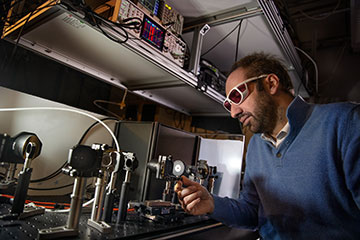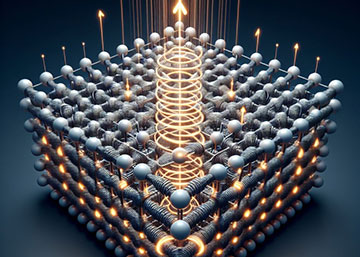
Stefano Bonetti in his lab at Stockholm University. [Image: Knut and Alice Wallenbergs Foundation/ Magnus Bergström]
The exceptional brevity of light pulses from modern lasers could yield a new generation of ultrafast magnetic switches. That is the upshot of new work by two independent groups that have reportedly shown that pulses lasting just trillionths of a second or less can temporarily turn an unmagnetic material magnetic by generating circular vibrations in the material’s atoms (Nature, doi: 10.1038/s41586-024-07175-9, 10.1038/s41586-024-07200-x).
Rotating atoms
Magnetization caused by rotation on a macroscopic scale is a phenomenon known as the Barnett effect. This involves aligning the intrinsic angular momenta, or spins, of the electrons inside a disordered magnetic material by rotating the material as a whole―thereby generating a net magnetic field inside it.
The new experiments instead involved rotation on the atomic scale in materials that are not normally magnetic. They relied on circularly polarized laser pulses rotating the materials’ atoms, such that the atoms yield collective circular vibrations called chiral phonons that are resonant with the laser frequency.
One of the experiments was carried out by an international group led by Stefano Bonetti at Stockholm University, Sweden, and the Ca’ Foscari University of Venice, Italy. Bonetti and colleagues pumped a sample of the nonmagnetic insulator strontium titanate with picosecond-long circularly polarized pulses from a 100-µm far-infrared laser. They detected the fleeting induced magnetization by sending in 800-nm, 0.04-ps probe pulses and measuring the rotation of these pulses' polarization.
More specifically, the researchers measured the probe pulses' Kerr rotation as they varied the temporal delay between pump and probe pulses. They then worked out the fast Fourier transform of the resulting time trace and plotted this value as a function of the material’s temperature. Varying the temperature from 160 to 360 Kelvin, they found the biggest response at 280 K (7°C)―at which point, they say, the terahertz electric field of the pump pulses was resonant with the material's first optical phonon mode.
According to Bonetti and colleagues, this experiment provides the first demonstration of laser light inducing quantum behavior at room temperature. They argue that the results could lead to faster and more energy-efficient computers, communication and data storage, pointing out that the duration of the induced magnetic moment―about a picosecond―is around an order of magnitude less than that of the fastest spin switching reported to date.
Narrowband pulses

Researchers have used picosecond-long circularly polarized laser pulses to temporarily induce magnetization in the nonmagnetic insulator strontium titanate, as shown in this AI-generated image. [Image: Alexander Balatsky]
Carl Davies, Andrei Kirilyuk and colleagues from Radboud University, Netherlands, working with collaborators at Nihon University, Japan, have also used circularly polarized infrared laser pulses in pump–probe experiments to induce temporary magnetization in a nonmagnetic material. But rather than using conventional broadband pulses, they exploited very narrowband pulses from the FELIX free-electron lasers at Radboud University, allowing them to better target specific lattice vibrations at resonance. They also added an additional step―using the induced magnetization (in a synthetic sapphire and a glass–ceramic composite) to switch the magnetization of a magnetic alloy (gadolinium iron cobalt) placed on top of the paramagnet.
Given that the resulting switch is permanent, Davies and coworkers say that the phononic resonance could be used as a new and extremely fast method for writing data to magnetic media. By changing the direction of rotation of the circularly polarized light, they were able to change the handedness of the phonons and with that the direction of magnetization.
Writing a commentary piece to accompany the papers, published in Nature, Carl Romao of the Swiss Federal Institute of Technology, Switzerland, and Dominik Juraschek of Tel Aviv University, Israel, liken the process of magnetization in both experiments to that generated by sending an electric current through a coil of wire. “The pump pulses excite the material’s ions to rotate,” they say, “generating a circular current that resembles a miniature electromagnetic coil, which in turn induces magnetization.”
Further testing
Romao and Juraschek agree that the new results could lead to improvements in magnetization-based electronics and computing, but they say that questions remain about certain aspects of the research. On the basis that the phonons’ angular momentum is converted to electronic magnetization, Bonetti and colleagues calculate the phonon magnetic moments to be about 10,000 times larger than predicted previously. Emerging theories that might explain the disparity, say Romao and Juraschek, could be tested by electron and X-ray scattering experiments.
The pair adds that further work is also needed to better understand Kirilyuk and colleagues’ finding that chiral phonons can influence magnetic order remotely. The mechanism and magnitude of the angular momentum's propagation through a crystal, they say, are “issues worthy of investigation.”
